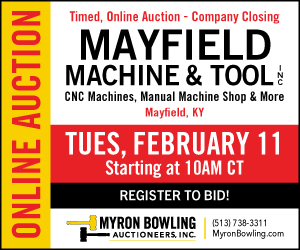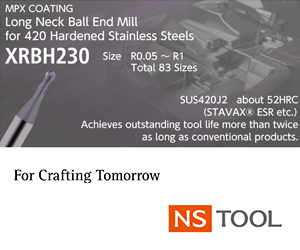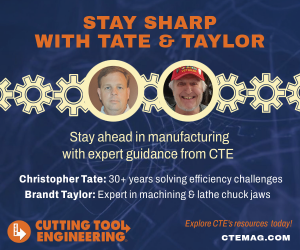
Courtesy of All images: RS Precision
RS Precision Industries in Farmingdale, N.Y.
The following is an interview with Robert Savitzky, president of RS Precision Industries, Farmingdale, N.Y. The interview was conducted by Contributing Editor Bill Kennedy. During the last 6 decades, RS Precision has transformed from a traditional tool and die maker to a manufacturer of microscale parts. Abe Savitzky, Robert’s father, started the company in 1948 to make tool steel and carbide progressive stamping dies for the zipper industry. In 1960, Abe bought an EDM to facilitate die production, but soon realized its potential as a production machine. The company adopted CNC technology in 1985, employing an Enshu vertical machining center to cut parts prior to heat treatment. Technology changes in the electronics industry in the early 1990s resulted in a sudden 50 percent decline in demand for electronics assembly tooling. Fortuitously, the opportunity to make small parts developed at about the same time, enabling RS Precision to gradually complete its transition. After working as a manufacturing engineer for Hewlett Packard, Robert Savitzky joined the company in 1978 and became president when Abe retired in 1986.

Robert Savitzky, right, discusses a part print with RS Precision 's EDM supervisor in front of the shop’s Mitsubishi EA8PV micro-holemaking sinker EDM.
Kennedy: How does your shop differ from a tool and die shop?
Savitzky: A typical tool and die shop is geared for one-at-a-time production and has a certain culture and a deliberate, careful pace. A die maker gets a blueprint of a stamped part and must design and build the tool to produce it. It is a considerable engineering and creative undertaking that requires exceptional visualization skills and craftsmanship. From an economic and a cultural point of view, a tool and die shop is not suited to production work. My father brought the tool and die processes from hand filing and machine fitting of punch and die cavities to form grinding and EDMing, thus transitioning the shop from one- or two-piece production to a mode more like a machine shop.
Kennedy: What aspects of the tool and die tradition aided the transition?
Savitzky: Most of all, meticulous attention to detail and a relentless pursuit of excellence. Many of our core competencies were a great fit for micromachining.
Kennedy: What challenges did you have to overcome in the transition?
Savitzky: When I first came to the company, methods for producing parts were in the hands of lead people, die makers. As a consequence, the methods were not consistent from batch to batch and repeatability was not predictable. My father’s efforts were essentially creative; he didn’t work out manufacturing details on paper. I initiated detailed operation sheets that contained the essential points for successfully making the parts. I performed engineering and documentation functions and supervised the shop to ensure jobs were done the way our method sheets required. I picked the brains of the smart people around me, highlighted the problems and asked for their advice on how to solve them. More importantly, I asked what concepts were behind their solutions. We developed innovative and effective solutions from this deep conceptual understanding of the problems.
Kennedy: How did your shop get into micromachining?
Savitzky: We didn’t look for it, it just happened. We bid on a high-precision part about the size of a small jellybean. The part had 0.005 "- to 0.010 "-thick walls and tiny holes, including two off-center, 0.019 "-dia. holes that opposed each other through the part’s walls. The holes had to be in line within tenths. We learned how to make the part through trial and error. The first time we attempted making the holes using a drill jig. However, getting the holes in the right location relative to all the other features was difficult. Using a CNC machine with an indexing head, we were able to machine a number of features in perfect relationship to each other.
Kennedy: What were some of the biggest technical challenges you faced in moving to micromachining?
Savitzky: Early on, the primary challenge was how to hold fragile, thin-walled parts securely but gently enough so we didn’t damage or distort them. We had a great deal of experience building fixtures for small parts; when people sent parts for secondary EDMing operations, we had to learn how to hold them. We tended to use a lot of V-block-style fixtures because we could form grind them precisely and easily.
Kennedy: Your work is obviously fixture-intensive. How do you maintain productivity?
Savitzky: Modular tooling is an important piece of the puzzle. Our modular tooling from System 3R provides palletizing and setup reduction, and we are able to hold the workpieces in custom fixtures securely and with repeatability. We use modular tooling to move the fixture from a milling machine to an EDM with tight positional control. And with modular tooling, we can run smaller lots. For example, if a customer ordered 300 parts to be delivered over a period of 3 or 6 months, previously we would have had to run all 300 parts, and the lead time from start to finish was excessive. With modular tooling, we can cut our lots down to 100 or even 25 parts, because our setups are now plug-in simple.
Kennedy: What is your specialty?
Savitzky: EDMing and, to some extent, grinding are still key strengths in terms of having a happy customer and making a profit. In straight conventional machining, where the part has no EDMing, no grinding or no problem machining, we are not competitive. But that is going to change. We recently purchased a Mori Seiki NT-1000 multiaxis, mill/turn machine. It is not geared specifically to microparts, but to parts that are, to continue the food analogy, more the size of a large jelly bean to maybe a grapefruit. This equipment will give us competitive machining capability.
Kennedy: What’s an example of a part that can’t be created without EDMing?
Savitzky: A small part that has a deep rectangular pocket with a flat bottom and sharp corners to, let’s say, accommodate a miniature circuit board. We would rough mill the pocket and finish it with EDMing. In conventional machining, either the tool rotates or the workpiece rotates. This imposes design constraints. We say, “End the tyranny of rotation.” With our approach, we free the engineer from those constraints so he can design parts for superior performance and gain a competitive advantage.
Kennedy: Do you have a standard approach toward machining small parts?
Savitzky: No. Every job has to be analyzed. The part tells you how it needs to be produced, if you listen attentively enough. I’m serious. Methodizing and engineering the kind of jobs we do, to the level we do, is almost a Zen experience. And you have to think of the method as a chain. The machine tool is one of the links. Modular tooling is a link. Workholding fixtures are a link. Even the parts themselves are a link. Every link in the chain has to be strong or the process will fail.
Related Glossary Terms
- computer numerical control ( CNC)
computer numerical control ( CNC)
Microprocessor-based controller dedicated to a machine tool that permits the creation or modification of parts. Programmed numerical control activates the machine’s servos and spindle drives and controls the various machining operations. See DNC, direct numerical control; NC, numerical control.
- drill jig
drill jig
Accessory that holds a workpiece securely while guiding a drill or other tool into the workpiece. Ensures accurate, repeatable location.
- electrical-discharge machining ( EDM)
electrical-discharge machining ( EDM)
Process that vaporizes conductive materials by controlled application of pulsed electrical current that flows between a workpiece and electrode (tool) in a dielectric fluid. Permits machining shapes to tight accuracies without the internal stresses conventional machining often generates. Useful in diemaking.
- filing
filing
Operation in which a tool with numerous small teeth is applied manually to round off sharp corners and shoulders and remove burrs and nicks. Although often a manual operation, filing on a power filer or contour band machine with a special filing attachment can be an intermediate step in machining low-volume or one-of-a-kind parts.
- fixture
fixture
Device, often made in-house, that holds a specific workpiece. See jig; modular fixturing.
- flat ( screw flat)
flat ( screw flat)
Flat surface machined into the shank of a cutting tool for enhanced holding of the tool.
- gang cutting ( milling)
gang cutting ( milling)
Machining with several cutters mounted on a single arbor, generally for simultaneous cutting.
- grinding
grinding
Machining operation in which material is removed from the workpiece by a powered abrasive wheel, stone, belt, paste, sheet, compound, slurry, etc. Takes various forms: surface grinding (creates flat and/or squared surfaces); cylindrical grinding (for external cylindrical and tapered shapes, fillets, undercuts, etc.); centerless grinding; chamfering; thread and form grinding; tool and cutter grinding; offhand grinding; lapping and polishing (grinding with extremely fine grits to create ultrasmooth surfaces); honing; and disc grinding.
- jig
jig
Tooling usually considered to be a stationary apparatus. A jig assists in the assembly or manufacture of a part or device. It holds the workpiece while guiding the cutting tool with a bushing. A jig used in subassembly or final assembly might provide assembly aids such as alignments and adjustments. See fixture.
- machining center
machining center
CNC machine tool capable of drilling, reaming, tapping, milling and boring. Normally comes with an automatic toolchanger. See automatic toolchanger.
- milling
milling
Machining operation in which metal or other material is removed by applying power to a rotating cutter. In vertical milling, the cutting tool is mounted vertically on the spindle. In horizontal milling, the cutting tool is mounted horizontally, either directly on the spindle or on an arbor. Horizontal milling is further broken down into conventional milling, where the cutter rotates opposite the direction of feed, or “up” into the workpiece; and climb milling, where the cutter rotates in the direction of feed, or “down” into the workpiece. Milling operations include plane or surface milling, endmilling, facemilling, angle milling, form milling and profiling.
- milling machine ( mill)
milling machine ( mill)
Runs endmills and arbor-mounted milling cutters. Features include a head with a spindle that drives the cutters; a column, knee and table that provide motion in the three Cartesian axes; and a base that supports the components and houses the cutting-fluid pump and reservoir. The work is mounted on the table and fed into the rotating cutter or endmill to accomplish the milling steps; vertical milling machines also feed endmills into the work by means of a spindle-mounted quill. Models range from small manual machines to big bed-type and duplex mills. All take one of three basic forms: vertical, horizontal or convertible horizontal/vertical. Vertical machines may be knee-type (the table is mounted on a knee that can be elevated) or bed-type (the table is securely supported and only moves horizontally). In general, horizontal machines are bigger and more powerful, while vertical machines are lighter but more versatile and easier to set up and operate.
- milling machine ( mill)2
milling machine ( mill)
Runs endmills and arbor-mounted milling cutters. Features include a head with a spindle that drives the cutters; a column, knee and table that provide motion in the three Cartesian axes; and a base that supports the components and houses the cutting-fluid pump and reservoir. The work is mounted on the table and fed into the rotating cutter or endmill to accomplish the milling steps; vertical milling machines also feed endmills into the work by means of a spindle-mounted quill. Models range from small manual machines to big bed-type and duplex mills. All take one of three basic forms: vertical, horizontal or convertible horizontal/vertical. Vertical machines may be knee-type (the table is mounted on a knee that can be elevated) or bed-type (the table is securely supported and only moves horizontally). In general, horizontal machines are bigger and more powerful, while vertical machines are lighter but more versatile and easier to set up and operate.
- modular tooling
modular tooling
1. Tooling system comprised of standardized tools and toolholders. 2. Devices that allow rapid mounting and replacement of tools. Commonly used with carousel toolchangers and other computerized machining operations. See toolchanger; toolholder.








